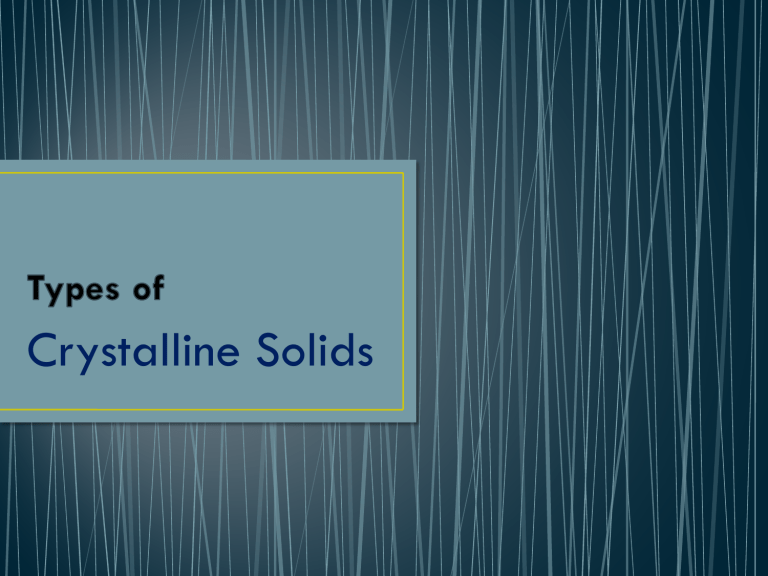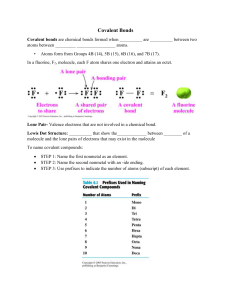
Crystalline Solids
Metallic crystals are also atomic solids, made
of metal atoms held together by metallic
bonds. These metallic bonds are what give
metals their malleability and ductility, as they
allow the metal atoms to roll and slide past
each other without breaking the material.
The metallic bonds also allow valence
electrons to move freely throughout the metal
in an "electron sea," which makes them great
conductors of electricity. Their hardness and
melting points vary widely
X-ray analysis of different Metallic
Crystals have shown that metals adopt either
of the following structures:
*Body Centered Cubic structure(BCC)
*Face Centered Cubic structure(FCC)
*Hexagonal Closed-Packed structure(HCP)
Atomic number
12
Atomic mass
24.305 g.mol -1
Electronegativity according
1.2
to Pauling
Density
1.74 g.cm -3 at 20
°C
Melting point
650 °C
Boiling point
1107 °C
Vanderwaals radius
0.16 nm
Ionic radius
0.065 nm
Isotopes
5
Electronic shell
[Ne] 3s2
Energy of first ionisation
737.5 kJ.mol -1
Energy of second
ionisation
1450 kJ.mol -1
Standard potential
- 2.34 V
Discovered by
Sir Humphrey
Davy in 1808
•
Atomic number
13
Atomic mass
26.98154 g.mol -1
Electronegativity accor
1.5
ding to Pauling
Density
2.7 g.cm -3 at 20 °C
Melting point
660.4 °C
Boiling point
2467 °C
Vanderwaals radius
0.143 nm
Ionic radius
0.05 nm
Isotopes
3
Artificial isotopes
16
Electronic shell
1s2 2s2 2p6 3s2 3p1
Energy of first
ionization
577.4 kJ.mol -1
Energy of second
ionization
1816.1 kJ.mol -
Energy of third
ionization
2744.1 kJ.mol -1
Standard potential
- 1.67 V
Discovered by
Hans Christian Oersted
in 1825
Atomic number
11
Atomic mass
22.98977 g.mol -1
Electronegativity
according to
Pauling
0.9
Density
0.97 g.cm -3 at 20
°C
Melting point
97.5 °C
Boiling point
883 °C
Vanderwaals radius 0.196 nm
Ionic radius
0.095 (+1) nm
Isotopes
3
Electronic shell
[Ne] 3s1
Energy of first
ionisation
495.7 kJ.mol -1
Standard potential
- 2.71 V
Discovered by
Sir Humphrey Davy
in 1807
READ MORE HERE:
https://www.lenntech.com/periodic/elements/na.htm
https://thefactfactor.com/facts/pure_science/chemistry/inorganic-chemistry/concept-ofmetallic-bond-and-metallic-solids/12900/
https://www.schoolmykids.com/learn/interactive-periodic-table/
https://www.google.com/image
Sodium Chloride Properties (Theoretical)
Compound Formula
NaCl
Molecular Weight
58.44
Appearance
Colorless crystals
Melting Point
801° C (1,474° F)
Boiling Point
1,413° C (2,575° F)
Density
2.16 g/cm3
Solubility in H2O
35.7 at 273K GPa
Crystal Phase / Structure
FCC
Poisson's Ratio
0.252
Specific Heat
854
Thermal Conductivity
1.15 at 273K W·m-1·K-1
Thermal Expansion
44 X 10-6
Young's Modulus
39.98
Exact Mass
57.9586 g/mol
Monoisotopic Mass
57.958622 Da
•
•
•
•
The most well known ionic solid is sodium chloride, also known by its geological names as rock-salt or halite. We can look
at this compound in both structural and energetic terms.
Rock SaltStructurally, each ion in sodium chloride is surrounded and held in tension by six neighboring ions of opposite
charge. The resulting crystal lattice is of a type known as simple cubic, meaning that the lattice points are equally spaced
in all three dimensions and all cell angles are 90°.
Figure \(\PageIndex{2}\): The differently-colored circles represent the Na+ and Cl– ions; because their locations are
geometrically equivalent, it does not matter which color is assigned to which ion.In Figure \(\PageIndex{2}\), we have
drawn two imaginary octahedra centered on ions of different kinds and extending partially into regions outside of the
diagram. (We could equally well have drawn them at any of the lattice points, but show only two in order to reduce
clutter.) Our object in doing this is to show that each ion is surrounded by six other ions of opposite charge; this is known
as (6,6) coordination. Another way of stating this is that each ion resides in an octahedral hole within the cubic lattice.
How can one sodium ion surrounded by six chloride ions (or vice versa) be consistent with the simplest formula NaCl? The
answer is that each of those six chloride ions also sits at the center of its own octahedron defined by another six sodium
ions. You might think that this corresponds to Na6Cl6, but note that the central sodium ion shown in the diagram can claim
only a one-sixth share of each of its chloride ion neighbors, so the formula NaCl is not just the simplest formula, but
correctly reflects the 1:1 stoichiometry of the compound. But of course, as in all ionic structures, there are no
distinguishable "molecular" units that correspond to the NaCl simplest formula. Bear in mind that large amount of empty
space in diagrams depicting a crystal lattice structure can be misleading, and that the ions are really in direct contact with
each other to the extent that this is geometrically possible
•
Sodium fluoride is a colorless crystalline solid or white powder, or the solid dissolved in a liquid. It is soluble
in water. It is noncombustible.One example of an ionic bond is the formation of sodium fluoride, NaF, from a
sodium atom and a fluorine atom. In this reaction, the sodium atom loses its single valence electron to the
fluorine atom, which has just enough space to accept it.Physical properties: Sodium fluoride is found as an
odorless, crystalline solid that is white to greenish in color, depending on its purity. Its density is 2.56 g/mL,
melting point is 993 °C, and boiling point is 1,704 °C. It is a hygroscopic solid (absorbs moisture from
air).NaF is prepared by neutralizing hydrofluoric acid or hexafluorosilicic acid (H2SiF6), both byproducts of
the reaction of fluorapatite (Ca5(PO4)3F) from phosphate rock during the production of superphosphate
fertilizer. Neutralizing agents include sodium hydroxide and sodium carbonate.Sodium fluoride is an
inorganic compound with the formula NaF. It is used in trace amounts in the fluoridation of drinking water, in
toothpaste, in metallurgy, and as a flux, and is also used in pesticides and rat poison. It is a colorless or
white solid that is readily soluble in water. Sodium fluoride is an inorganic ionic compound, dissolving in
water to give separated Na+ and F− ions.
IUPAC ID: Sodium fluoride
Formula: NaF
Molar mass: 41.98817 g/mol
Melting point: 993 °C
Boiling point: 1,695 °C
Density: 2.56 g/cm³
Soluble in: Water
• https://chem.libretexts.org/Bookshelves/General_Chemistry/M
ap%3A_A_Molecular_Approach_(Tro)/12%3A_Solids_and_M
odern_Materials/12.05%3A_The_Structure_of_Ionic_Solids
• https://www.google.com/image
• https://www.chemeurope.com/en/encyclopedia/Copper%28II
%29_nitrate.html
A covalent crystal contains a three-dimensional network of covalent bonds, as illustrated by the structures of
diamond, silicon dioxide, silicon carbide, and graphite. Graphite is an exceptional example, composed of planar
sheets of covalent crystals that are held together in layers by non covalent forces. Unlike typical covalent solids,
graphite is very soft and electrically conductive. Covalent network solids include crystals of diamond, silicon,
some other nonmetals, and some covalent compounds such as silicon dioxide (sand) and silicon carbide
(carborundum, the abrasive on sandpaper). Many minerals have networks of covalent bonds. The atoms in these
solids are held together by a network of covalent bonds, as shown in Figure 5. To break or to melt a covalent
network solid, covalent bonds must be broken. Because covalent bonds are relatively strong, covalent network
solids are typically characterized by hardness, strength, and high melting points. For example, diamond is one of the
hardest substances known and melts above 3500 °C
Steps for Identifying Covalent Network Solids
Step 1: Carefully look at the structure and take note of the interactions or bonds that hold the atoms together.
Step 2: Determine whether covalent bonds span the entirety of the structure. If covalent bonds span the entire
structure, it is a covalent network solid.
A covalent bond is formed between two adjacent atoms wherein the electrons in the bond are shared equally
between the two atoms.
Covalent Network Solid: A covalent network solid is a continuous network of covalently bonded atoms that spans
the entirety of the material. A covalent network solid can be considered a macromolecule (a large molecule) since
atoms in any part of the solid will be covalently bound to other atoms in the solid.
Now that we have learned what covalent network solids are, let's take a look at a few examples to learn how to
properly identify them.
• Methane is a chemical
compound with the
chemical formula CH₄. It
is a group-14 hydride,
the simplest alkane, and
the main constituent of
natural gas.
• Formula: CH₄
• IUPAC ID: Methane
• Molar mass: 16.04 g/mol
• Boiling point: -161.6 °C
• Melting point: -182 °C
• Density: 0.657 kg/m³
• Soluble in: Water,
Methanol, Ethanol,
Benzene, Acetone,
Toluene, Diethyl ether
Methane (CH4) is a non-polar hydrocarbon compound composed out of a
single carbon atom and 4 hydrogen atoms. Methane is non-polar as the
difference in electronegativities between carbon and hydrogen is not great
enough to form a polarized chemical bond. Aside from that Ch4 is nonpolar
because all of the nonpolar covalent bonds are spaced within a tetrahedral
structure around the molecule. Polarity and Boiling Point: The polarity of the
molecules determines the forces of attraction between the molecules in the
liquid state. Solid CH4 is a molecular solid. In this, the constituent molecules
are held together by vander Waal's forces.
•
Solid sulfur dioxide is a polar molecular solid because the net dipole moment
is non zero and constituent particles are molecules. The electronegativity of
sulfur is 2.5 and that of oxygen is 3.5. Sulfur dioxide is most noteworthy as an
environmental pollutant. It is formed when materials containing sulfur are
burned, and is thus an important air pollutant, especially in the vicinity of
smelters and plants burning soft coal or high sulfur oil. Others are automobile
exhaust, wood-burning stoves, pulp mills, and smelters. Note that, in addition
to sulfur dioxide itself, many related compounds and decay products of sulfur
dioxide—such as sulfurous and sulfuric acids, sulfates, sulfites, and bisulfites—
are present in the ambient air. It is beyond the scope of this brief review to
describe all the information on all these substances; only sulfur dioxide will be
addressed.
PHYSICAL AND CHEMICAL PROPERTIES
Chemical formula:
SO2
Molecular weight:
64.07
CAS number:
7446–09–5
Specific gravity (liquid):
1.434
Specific gravity (gas):
2.927
Solubility:
Soluble in water, alcohols, acetic acid, and sulfuric
acid
General characteristics:
Colorless, nonflammable gas or liquid; strong
suffocating odor
Conversion factors:
1 ppm=2.6 mg/m3
1 mg/m3 =0.38 ppm
•
Ice is a hydrogen bonded molecular crystal.A crystalline solid that consists
molecules held together by intermolecular forces. They are non-conductors of
electricity and are volatile liquids or soft solids under room temperature and
pressure. Ice is a unique substance because its solid state — ice — is less dense
than its liquid state. Physical properties are characteristics of a substance. They
do not change. Physical properties include color, smell, freezing/melting point,
and density.Ice, like all solids, has a well-defined structure; each water molecule
is surrounded by four neighboring H2Os. two of these are hydrogen-bonded to
the oxygen atom on the central H2O molecule, and each of the two hydrogen
atoms is similarly bonded to another neighboring H2O. In the solid state (ice),
intermolecular interactions lead to a highly ordered but loose structure in
which each oxygen atom is surrounded by four hydrogen atoms; two of
these hydrogen atoms are covalently bonded to the oxygen atom, and the
two others (at longer distances) are hydrogen bonded to the oxygen atom's
.
• https://www.nap.edu/read/690/chapter/15
• https://study.com/skill/learn/how-to-identify-covalent-networksolids-explanation.html
• https://thefactfactor.com/facts/pure_science/chemistry/physic
al-chemistry/classification-of-crystalline-solids/6939/
• https://opentextbc.ca/chemistry/chapter/10-5-the-solid-stateof-matter/
• https://www.google.com/image
Submitted by:
Aljohn C. Habitan
Submitted To:
Ms. Analyn Mandane



